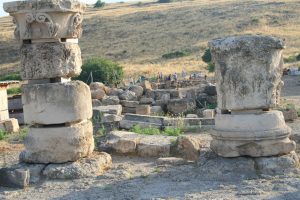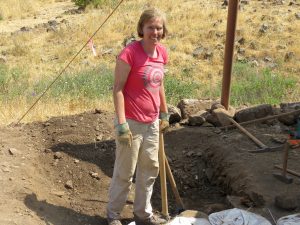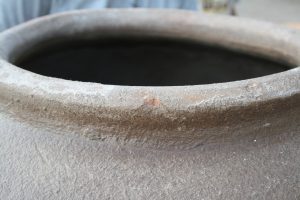
DIRT AND MIRRORS: SEEING OMRIT IN REVERSE
Katherine A. Shaner, 2017 William Dever Fellowship Recipient
This summer I learned how to do things backwards. I was not exactly a newbie to archaeological materials. Earlier this spring I completed my first book (Enslaved Leadership in Early Christianity, Oxford, expected January 2018) examining slaves’ roles within 1st and 2nd century c.e. religious communities in Asia Minor using many inscriptions, reliefs, and artifacts in my analysis. My research involved scouring site reports, deciphering field notes, looking at photos from decades past, talking with excavators, climbing around the spaces and features left from their work. But I had never actually dug in the dirt. So, as I packed my trowel and tape measure (and sunblock), I was almost giddy to actually do the work of excavating at Omrit, up north in the Huleh Valley. Omrit, I knew, was the site of a very large Roman temple complex that began as a small but beautiful Hellenistic shrine. I also knew that for several years the team had been digging in the settlement complex just outside the temenos wall and that this season would focus on this complex again. Since my scholarship concentrates on women, slaves, and those who are often left out of our historical and religious narratives, this seemed like the perfect place to begin learning about archaeological work in Israel.
As soon as I arrived at Omrit, however, I realized that all my research skills, my ability to look at spaces and objects, all my analysis of socio-political and religious constructions using archaeological materials, all of what I thought I knew about archaeology was, in fact, a mirror image. All the familiar “vocabulary” was backwards. There were no rooms to stand in or floors to examine or small finds with precise details to pour over. There was just dirt packed in among these things. So, when I first saw my square for the season at 5am on a Saturday morning, it took some mental gymnastics for me to switch gears and to fully fathom the analytical work of the coming weeks. As we slowly moved down, through layers of fill within at least three discernable inhabitation layers, walls and features began to appear from the solid soil. The empty spaces of ancient rooms that I was accustomed to weren’t so empty. Until…
One Saturday morning, I swung my pick axe and it slid into an air pocket. We’d been finding air pockets all morning (we later discovered that those air pockets were the basalt capstones from a second or third century c.e. drain system). But this pocket was different. Not only did the axe sink into it, but a distinctive, clear, echo-y ring accompanied it. As I pulled the axe up, imagine my surprise when a flat piece of conglomerate lifted to reveal the rim and hollow interior of a pithos, in situ. I am no pottery expert, but I knew we’d found something remarkable. Once we examined the piece more closely, I discovered just how lucky that pick-axe swing was: the slight knick I’d left on the rim (see photo) could have been much more destructive if it had hit with a little more force or struck just a few centimeters in a different direction. Call it beginner’s luck if you’d like. I’m calling it yet another lesson in seeing “backwards.” It was only when my tools hit negative space that I could see that the solid ground all around me was actually the point of our work. It was the material that filled and contextualized the spaces that I’d analyzed so often. (If you want to know more about the stratigraphy, find situation, context, analysis, and interpretation of this find you will have to wait for the published report. No spoilers allowed here).
As the team worked to finalize our locus lists and depositional histories, I realized that the season’s work helped me see much more clearly, not just the walls and their relationship to each other, or the floor levels and their relationship to the fills underneath and on top of them, but also the ways that decisions about which soil to move, which objects to wash or not wash, which walls to take down and which to leave ultimately affect the possibilities for writing histories and understanding socio-political contexts for religious practices. For someone like me, who studies women, slaves, and others often left out of our usual religious histories, these possibilities are the very essence of my work.
Once the dig season was finished, I packed my bags and relocated to the Albright Institute for Archaeological Research in Jerusalem. I quickly learned that the summer months at the Albright are quite special. People are constantly coming and going from various dig sites and research projects, and the community in residence is constantly changing. As an institution, it brilliantly engineers conversations between scholars who might not ordinarily run into each other. Conversation over dinner often sparked my imagination about research tools or methods for recording archaeological data that I’d never encountered. I found myself talking with chalcolithic and paleolithic scholars, assyriologists, bronze and iron age specialists, archaeobotanists and archaeozoologists, epigraphers and textile specialists. I cannot imagine meeting this rich variety of colleagues any other way. I tried my hand at paleography one evening in the courtyard over beer and high resolution photographs (and I found it fascinating—anyone need a Greek epigrapher for their staff?). I heard stories about dig seasons past and legendary archaeology antics. I learned about the legal ambiguities and ethical quandaries of digging in a place like Israel and the Palestinian territories over dinner. All the while I had the time to visit many sites around the city and around the country. I also had space and encouragement to think widely and deeply about the relationship between archaeology and biblical studies. Several project concepts and outlines came from this rich time. My research and publication work for the next few years will certainly be stronger and more expansive for this summer’s experiences.
The intent of the Dever Fellowship is to foster dialogue between archaeology and biblical studies, particularly in institutions of higher education. Certainly, the fellowship helped me see where I might fit into that goal. In my work with New Testament and early Christian materials, I find an increasing need to contextualize not only texts but interpretations and practices in the material worlds from which they emerge. The opportunity to work backwards through the dirt, to shine a mirror on my own previous work, to encounter new sites, to build another network of colleagues, and to explore new possibilities for my own research agenda was invaluable for me. I am very grateful to William Dever and the ASOR selection committee for generously funding these two months. I am also grateful to the leadership team at Omrit (Jennifer Gate-Foster, Michael Nelson, Benjamin Rubin, Jason Schlude, and Dan Schowalter) for including me in this season’s work.
Katherine A. Shaner teaches New Testament at Wake Forest University School of Divinity. She teaches courses across the New Testament and early Christian history that explore the theological, social, and political implications of biblical interpretation for contemporary communities.


